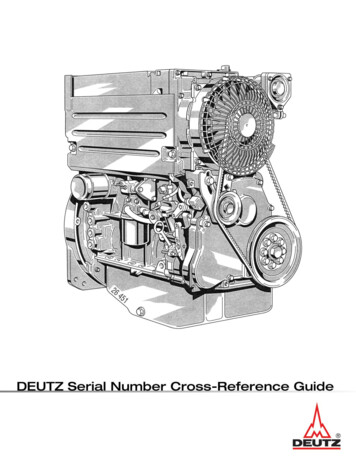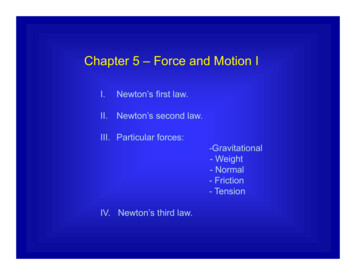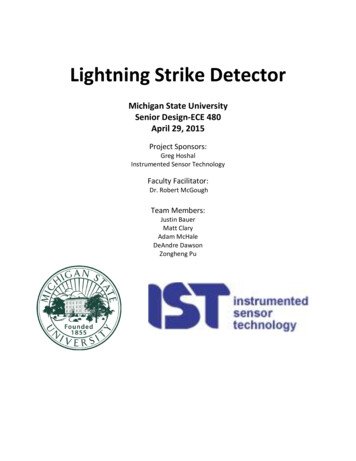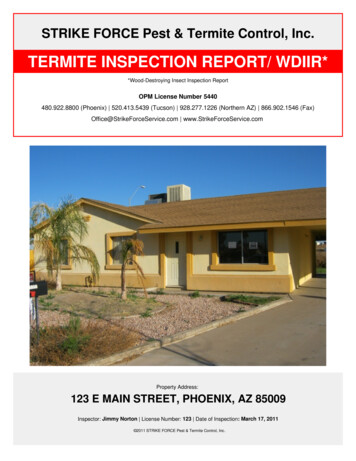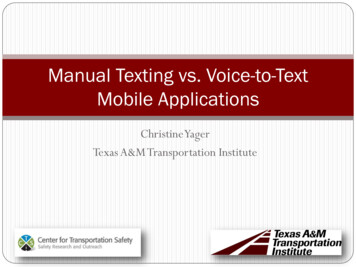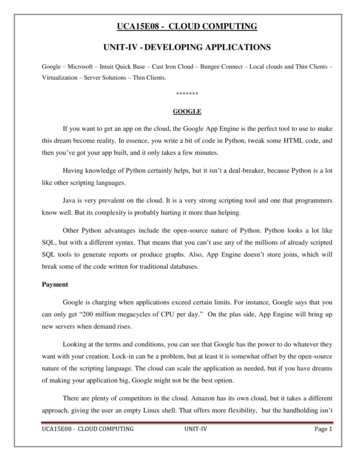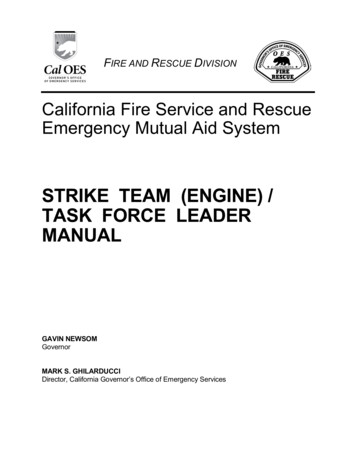
Transcription
FIRE AND RESCUE DIVISIONCalifornia Fire Service and RescueEmergency Mutual Aid SystemSTRIKE TEAM (ENGINE) /TASK FORCE LEADERMANUALGAVIN NEWSOMGovernorMARK S. GHILARDUCCIDirector, California Governor’s Office of Emergency Services
MANUAL OF PROCEDURES AND DUTIESSTRIKE TEAM (ENGINE) / TASK FORCE LEADERBRIAN MARSHALL, ChiefFire and Rescue Division1Rev 4/2019
CALIFORNIA GOVERNOR’S OFFICE OF EMERGENCY SERVICESSTRIKE TEAM (ENGINE) / TASK FORCE LEADER MANUALTABLE OF CONTENTSPAGEIntroduction . 4Response Preparation . 6Needs . 6Duties and Responsibilities. 7Operational Procedures. 9Procedures and Policies – Cal OES (OES) Engines. 13Cal OES Fire and Rescue Mutual Aid Regions. 14Engine Strike Team/Task Force Responsibilities. 15Code of Conduct for Strike Teams . 16Tactics and Safety (Guide Only)Supplementary Information No. 1 - Fire Engine Capabilities and Tactics . 17Supplementary Information No. 2 - Wildland Hoselays . 27Burnout vs. Backfire – Is there a difference?. 31Incident Command System Organization Chart . 32Unit Log (Form ICS-214) (EXAMPLE). 33Objectives (Form ICS-202) (EXAMPLE) . 34Assignment List (Form ICS-204) (EXAMPLE). 35Demobilization/Release . 36Demobilization Checkout (Form ICS-221). 37Incident Demobilization Vehicle Safety Inspection (Form ICS 212). 39Incident Personnel Performance Rating (Form ICS 225). 412Rev 4/2019
CALIFORNIA GOVERNOR’S OFFICE OF EMERGENCY SERVICESSTRIKE TEAM (ENGINE) / TASK FORCE LEADER MANUALPAGEAPPENDIX A -- Communications. 42APPENDIX B -- Trespass/Occupation Letter . 53APPENDIX C – Motel Guidelines . 54APPENDIX D – Engine Standards by Type . 55APPENDIX E – ICS Map Display Symbology . 57APPENDIX F -- Backfire Authority Memorandum . 58Strike Team Leader Dispatch Worksheet. 593Rev 4/2019
CALIFORNIA GOVERNOR’S OFFICE OF EMERGENCY SERVICESSTRIKE TEAM (ENGINE) / TASK FORCE LEADER MANUALINTRODUCTIONOn January 1, 2009, the Governor’s Office of Emergency Services (OES) merged withthe Office of Homeland Security (OHS) under provisions set forth under Assembly Bill38 and became the California Emergency Management Agency (Cal EMA). In 2013, theagency was renamed the California Governor’s Office of Emergency Services (CalOES); herein throughout the remainder of this document, all current references to theGovernor’s Office of Emergency Services (OES) and the California EmergencyManagement Agency (Cal EMA) will now reflect the name change, Cal OES, whilehistorical references will remain as OES and Cal EMA, respectively.This document is provided for Cal OES (OES) and local government (LG) Strike TeamLeaders-Engine (STEN) / Task Force Leaders (TFLD) and Company Officers. It willprovide guidance in the preparation and operation of your Cal OES (OES)/LG StrikeTeam at any incident. The information presented is based on past experience,recognized standards, and Cal OES/LG policies and procedures.The Strike Team/Task Force has become an effective tool in the emergencymanagement of incidents of all types. The use of Strike Teams and/or Task Forcesenables the responsible jurisdiction to make incident assignments on a team basis. Fireapparatus and crews, with a team leader, arrive as a team, work as a team, and arereleased or reassigned as a team.ENGINE STRIKE TEAM TYPES AND MINIMUM STANDARDSRequests for apparatus should always be by ICS Type and Kind:KINDEStrikeNTeamGTypesNumber/TypeMINIMUM EQUIPMENT STANDARDSMINIMUM STAFFINGINESPerABCD5-Type 15-Type 25-Type 35-Type s.Pers.20020 Ft5001421FtExt.GPM50030020 1316FtFt4Rev 4/2019
CALIFORNIA GOVERNOR’S OFFICE OF EMERGENCY SERVICESSTRIKE TEAM (ENGINE) / TASK FORCE LEADER MANUALIn the Incident Command System (ICS) terminology a “Strike Team” is defined as:"Specified combinations of the same kind and type of resources, withcommon communications and a leader."In some instances, due to the nature of an incident, Task Forces may be formed. A TaskForce is defined as:"A group of resources with common communications and a leader,that may be pre-established and sent to an incident, or formed at anincident."It is important to understand the difference between Strike Teams and Task Forces. Anengine Strike Team is a specified number (5) and type of engines (Type I, II, III, or IV),assembled for a tactical assignment on an emergency. A Task Force could be anycombination of engines, mixed with other types of suppression and rescue resources.An example of a Task Force is two engines, a water tender, and a hand crew with aleader.If you are a Strike Team Leader or Company Officer, many thoughts will flash throughyour mind when your department is assigned to a major emergency. Is a Strike Team Leader Trainee (STEN-T) available? What personal items and clothing do you need to pack? Is all personal protective equipment (PPE) needed? Wildland and Structural? Will your strike team respond together or will you assemble at the emergency? Do you know where the incident is located? How will you get there? Do you need an Incident Order Number and Request Number? Can you communicate with your supervisor? Radio? Cell Phone? Who do you contact if you have a problem enroute to the emergency? On arrival, who do you report to? Will you need to complete special forms? Will a Cal OES Agency Representative (AREP) be at the incident?The list of questions you might ask yourself may be endless. The purpose of thisdocument is to present the information you need to answer these questions. Our goal isto prepare you to respond to any incident and perform the tasks you have beentrained for.5Rev 4/2019
CALIFORNIA GOVERNOR’S OFFICE OF EMERGENCY SERVICESSTRIKE TEAM (ENGINE) / TASK FORCE LEADER MANUALRESPONSE PREPARATIONMany fire departments in California have developed STRIKE TEAM KITS, which may becarried in a staff vehicle or on an engine. You may also wish to develop a checklist toassist you before leaving on an assignment that will require you to travel long distancesand be of an extended duration.REMEMBER: It may be some time before you eat and get a place tosleep. You can get wet, dirty, and cold. Be prepared to take care ofyour personal needs. Being properly prepared strengthens personalconfidence and security.NEEDS Credit Cards - Fuel, Personal, ATM, telephone calling card. Money - to be used for food, phone calls, other needs while traveling to and fromthe incident. Change of clothes, underwear, socks, and proper footwear. Personal items: toothpaste, toothbrush, shaving gear, toilet paper, bandanna,towel, replacement eye glasses/contact lens, etc. Medicine or medication, if required. Canteen, non-perishable food (freeze dried or MRE), canned juices, etc. Sleeping bag, blankets, cot, or sleeping pad. Safety equipment: Structural and wildland turnouts, helmet, gloves, fire shelter,goggles, boots (high top, all leather, lace-up, sewn lug sole), etc. Breathing apparatus (with spare bottles). First Aid Kit, eye-wash, aspirin, snake bite capability. Flash light, extra batteries. Portable (field programmable) VHF High Band radio, extra batteries, charger. Cellular telephone, pager, etc., extra batteries, chargers. Maps: AAA, Thomas Guide, topographic, etc. Belt weather kit and/or other Kestrel type device. Compass, GPS device, clipboard, tape, pencils, flagging, etc. Other items you may require for a long assignment.6Rev 4/2019
CALIFORNIA GOVERNOR’S OFFICE OF EMERGENCY SERVICESSTRIKE TEAM (ENGINE) / TASK FORCE LEADER MANUALNOTE: Don't forget the apparatus and its needs. If not carried, bring: Extra engine oil, transmission fluid. Engine drive belts.It is important to know the proper procedures to follow in the event problems developwhile enroute to, or returning from, a Strike Team/Task Force response. Do you havethe authority to purchase fuel, food, motel accommodations, or to repair apparatus andequipment? If you do not have the authority, it is important to know whom to contact forassistance. This document will address Cal OES policies and procedures that apply tofire departments assigned a Cal OES-owned (OES) fire engine. In any case, if youhave an emergency, contact the closest fire agency for temporary assistance. It isextremely important that you notify your Operational Area Fire and Rescue Coordinator(dispatch center) if you encounter problems on the road. They can make necessaryarrangements, provide direction, and contact your department for you.You should have these phone numbers with you at all times:1. Operational Area Fire and Rescue Coordinator Dispatch Center2. Regional Fire and Rescue Coordinator Dispatch Center3. Cal OES Fire and Rescue Division, Sacramento 24-Hour Number(916) 845-8911 (ask for the Fire Duty Officer)DUTIES AND RESPONSIBILITIESThe Strike Team/Task Force Leader selected to command the strike team SHOULDBE AN EXPERIENCED CHIEF OFFICER, knowledgeable in both structural andwildland fire control. Personnel responding to a Forest Agency or Master Mutual Aid(MMA) request for overhead positions shall meet the training requirements establishedfor the ICS position to be filled. (Reference: 2006 NWCG 310-1 and CICCS) Firedepartments, with the assistance of their Operational Area Fire and RescueCoordinator, will take part in the required Strike Team/Task Force Leader trainingclasses. Following successful completion of classes, individuals may be placed on alist as a Strike Team/Task Force Leader Trainee, if authorized by the Chief of theirdepartment and approved by the Operational Area CICCS Peer Review Committee.Strike Team/Task Force Leader "lists" are normally maintained by the Operational AreaFire and Rescue Coordinator's dispatch center.The Strike Team (Engine) / Task Force Leader is Responsible for:1. Overall safety and condition of the strike team, personnel and equipment.2. Movement of the strike team traveling to and returning from the emergency.7Rev 4/2019
CALIFORNIA GOVERNOR’S OFFICE OF EMERGENCY SERVICESSTRIKE TEAM (ENGINE) / TASK FORCE LEADER MANUAL3. Operational deployment of the strike team at the incident, as directed by theIncident Commander, or other member of the Incident Management Team.4. Familiarity with strike team operations, including assembling, responding, anddirecting the actions of the assigned units, keeping the team accounted for at alltimes.5. Assembling the units at the incident if the strike team is dispatched on an InitialAttack basis.6. Contacting the Cal OES AREP for assistance with problems encountered on theincident, including mechanical, operational, or logistical issues.7. Ensuring your vehicle has adequate communications capability. (FIRESCOPEField Operations Guide, ICS 420-1, Appendix A)8. Submitting all Apparatus Inventory forms (Cal OES/OES engine only) andEmergency Activity Record (F-42) forms for each engine company to Cal OESFire & Rescue Division, 3650 Schriever Ave., Mather, CA, 95655.9. The safety of all personnel and apparatus during a deployment. This includesemergency operations, while in staging areas, mobilization center, and whenreturning to home jurisdictions.10. Maintaining positive public relations for Cal OES, the incident, the agenciesrepresented on your Strike Team/Task Force, and the California Fire Service.Simply stated, the Strike Team Engine (STEN) / Task Force Leader (TFLD) must havethe capability and experience for managing, coordinating, and directing the actions offire crews/companies at a wide variety of emergency situations. This includesmaintaining all required records, and ensuring the logistical needs of all personnel aremet during the entire activation of the strike team/task force.A Strike Team/Task Force should include a Strike Team/Task Force Leader Trainee asa reimbursable member of the unit. The Trainee will be covered under the StrikeTeam/Task Force order-request number and will only be identified on a separate CalOES F-42 if from a different agency than the Strike Team/Task Force Leader. TheStrike Team/Task Force Leader Trainee should check in with the Incident TrainingSpecialist. The Trainee shall travel with the Strike Team/Task Force Leader in thesame vehicle. Personnel filling Strike Team/Task Force Leader Trainee positions shallbe certified at the Strike Team/Task Force Leader Trainee level per Wildland FireQualification; 2006 NWCG 310-1 Sub System Guide or the California IncidentCommand Certification System (CICCS).8Rev 4/2019
CALIFORNIA GOVERNOR’S OFFICE OF EMERGENCY SERVICESSTRIKE TEAM (ENGINE) / TASK FORCE LEADER MANUALOPERATIONAL PROCEDURESThe Strike Team/Task Force Leader will receive instructions at the time of dispatch bythe Operational Area Fire and Rescue Coordinator Dispatch Center. Informationshould consist of the following:I. INCIDENT ASSIGNMENTA. Incident Name and Type - if known; e.g., "Pinecrest Incident, interface firewith structural threat”.B. Incident Order Number - You will receive an Incident Order Number(example: CA-TGU-002791) if the Department of Forestry and FirePrevention (CAL FIRE), the United States Forest Service (USFS), the Bureauof Land Management (BLM), the National Park Service (NPS), or the Bureauof Indian Affairs (BIA) is the requesting agency. If local government is therequesting agency, you may receive this number after arrival at the incident.Enter this number on the Emergency Activity Record (Cal OES Form F-42,Box 3).C. Request Number - Associated with the Incident Order Number, you mustreceive a Request Number (example: TGU-E202). Enter on the EmergencyActivity Record (Cal OES Form F-42, Box 4).D. Reporting Location and Travel Route - Obtain detailed information, ifneeded; e.g., "Pinecrest Staging Area, Pasadena Convention Center, 2738New York Avenue, Pasadena, California”.Westbound I-210 Freeway to Altadena Off Ramp, north to New York Avenue.Follow signs when approaching staging area. Report to Captain John Doe,Pasadena Fire Department. Check-In on arrival. Radio contact, “PinecrestStaging, on 154.280 - White One.”E. Obtain Strike Team Number. The number is your identification and will beused to track and direct all movements of your strike team, both emergencyand non-emergency. (The Strike Team Number consist of a 3-letterdesignator; a 4-digit number, and a letter, e.g., (EMA) OES 2801A or XAL2004A)DO NOT CHANGE OR ALTER THIS NUMBER; it is yours from the beginningto the end of this period of mobilization.F. Communication Frequency - You will receive the radio frequency for yourcontact point on arrival at the incident; e.g., Staging Area 154.280 (WhiteOne) or Division A Supervisor 154.295 (White Three) for a line assignment.9Rev 4/2019
CALIFORNIA GOVERNOR’S OFFICE OF EMERGENCY SERVICESSTRIKE TEAM (ENGINE) / TASK FORCE LEADER MANUALII. INITIAL ATTACK, IMMEDIATE, OR PLANNED NEEDThe Requesting Agency should determine whether a Code-3 response is necessary.For INITIAL ATTACK or IMMEDIATE NEED, a Code-3 response is generallywarranted for response within an Operational Area or to an adjacent OperationalArea to PROTECT LIFE OR PROPERTY imminently threatened by the event.If the assignment is a PLANNED NEED, and will not begin until the next operationalperiod, or a designated time subsequent to the next period, it will be determined howmuch time is needed for the resources to prepare and respond, and whether theywill assemble at an established rendezvous point or at the incident. This will in turndetermine the departure time of the resources. If time permits, it is desirable for theresources to assemble and be briefed by the Strike Team/Task Force Leader priorto arriving at the incident.MODETIME FRAME LOCATION OF INCIDENTINITIAL ATTACKInstantly or as quickly Usually a Code-3 response as possiblefor protection of life andproperty Closest available mutual aid resourceswithin operational area or adjacentoperational area.IMMEDIATE NEEDMutual aid resources respond to incidentwithin 30 minutes from time of dispatchwithin operational area, adjacent or otheroperational area.May or may not be aCode-3 responsePLANNED NEEDNormally not a Code-3responseResponding within 30 minutesPlanned incidentarrival timedetermines departuretime. Should be ableto be en-route torendezvous within 1hour of request.10Resources will normally rendezvous atthe incident. May or may not rendezvous prior todeparture. Mutual aid resources respond within theoperational area, adjacent operationalarea, region, or state- as needed for thenext operational period or as determinedby requesting agency. Usually will rendezvous before departureand travel togetherRev 4/2019
CALIFORNIA GOVERNOR’S OFFICE OF EMERGENCY SERVICESSTRIKE TEAM (ENGINE) / TASK FORCE LEADER MANUALIII. AT THE RENDEZVOUS POINTA. Introduce yourself, the Trainee, the Company Officers, and team members.B. Inform the team what you know about the incident, and the strike team’sassignment. Determine your response route; consider time of day andfueling stops. Select one Engine Company Officer to "bring up the rear" whiletraveling, and to lead the Strike Team/Task Force in your absence (identifiedas “Alternate” STEN). Identify a common radio frequency for enroute striketeam communications.C. Conduct an assessment of the strike team to determine crew size andcapability, apparatus capability, special equipment carried, communicationcapability, etc.D. Identification – Cal OES (OES) Strike Team Leaders should have a Cal OESStrike Team Leader Kit. If you do not have one, contact the Cal OESAssistant Chief assigned to the incident. The kit includes:1. Operations Bulletin #8 (Cal OES Emergency Activity Record)2. Form F-42 (Cal OES Emergency Activity Record)3. Apparatus Inventory forms (Cal OES Form F-157), including sample4. Form ICS-214, Unit Log5. Strike Team Leader Control Record6. Bumper Stickers7. Strike Team (Engine) / Task Force Leader ManualThis packet of information is intended to make the required record keepingeasier; however, it should not hamper your primary mission if you do not receivethe "kit".At time of response, you may be requested to respond directly to aDivision/Group Supervisor for immediate assignment. The Strike Team/TaskForce Leader should check-in and obtain a briefing from the Division/GroupSupervisor as soon as possible after arrival.IV. ACTIVE ASSIGNMENTA. Reporting Location - Obtain detailed information.B. Incident Information - you should receive the following at time of dispatch:1. Incident Type and Check-In location11Rev 4/2019
CALIFORNIA GOVERNOR’S OFFICE OF EMERGENCY SERVICESSTRIKE TEAM (ENGINE) / TASK FORCE LEADER MANUAL2. Name of incident, if known3. Incident Order and Request Number4. Your Strike Team/Task Force designator5. Communications frequency (travel and tactical)6. Name of person to whom you are to report and radio call numberThe following is a position statement for a Strike Team/Task Force Leader. It will serveyou as an operational checklist at an incident. This information is found in theFIRESCOPE “Field Operations Guide” (FOG), Operations Section, Chapter 8 (FOG,ICS-420-1).The Strike Team/Task Force Leader reports to a Division/Group Supervisor and isresponsible for performing tactical assignments assigned to the Strike Team or TaskForce. The Leader reports work progress, status of resources, maintains work recordson assigned personnel, and relays other important information to their supervisor. Review Common Responsibilities, found in Chapter 1 of the FIRESCOPE “FieldOperations Guide.” Review assignments with subordinates, and assign tasks. Monitor work progress and make changes when necessary. Coordinate activities with adjacent strike teams, task forces and singleresources. Travel to and from active assignment area with assigned resources. Retain control of assigned resources while in available or out-of-service status. Submit situation and resource status information to Division/Group Supervisor. Maintain Unit/Activity Log (ICS Form 214). Refer to the FIRESCOPE “Field Operations Guide” (FOG, ICS-420-1). Refer to the National Wildfire Coordinating Group (NWCG) “Incident ResponsePocket Guide” (NFES 1077).12Rev 4/2019
CALIFORNIA GOVERNOR’S OFFICE OF EMERGENCY SERVICESSTRIKE TEAM (ENGINE) / TASK FORCE LEADER MANUALPROCEDURES AND POLICIES – Cal OES (OES) ENGINESThe following procedures and policies apply to Cal OES (OES) Engines. If you havequestions or doubts regarding any procedures, contact the Cal OES Assistant Chief atthe scene, or contact the Cal OES Fire and Rescue Division’s 24-Hour number: (916)845-8911, and ask for the Fire Duty Officer.1. The Voyager credit card carried on the Cal OES (OES) engine is to be used ONLYfor the assigned unit, and is restricted to certain purchases. (See Cal OESOperations Bulletin #11 - Credit Card Use, in the Cal OES [OES] Engine Log Book.) Gasoline or diesel fuel Fan belts (emergency purchase only) Tire repairs (emergency repair)2. Repair of Cal OES (OES) fire engines, in excess of 50.00, must have Cal OES Fireand Rescue Division approval.3. Cal OES (OES) Type I or Type II Engines are commonly requested for structuralprotection in a wildland or urban interface fire environment. They are not designedfor operations on narrow, rough, unsafe roads, dozer or brush trails. Use goodjudgment when deploying Cal OES (OES) fire apparatus during emergencyoperations. Plan ahead.4. Water tanks on Cal OES (OES) fire engines are not to be emptied to facilitate afaster response.5. Only qualified members of the assigned department shall drive and operate CalOES (OES) fire engines.6. Cal OES (OES) Engine Log Books are to be carried on all Cal OES (OES) Engines.Record all losses, repairs, and maintenance. When completing the Cal OES FireReport, attach all fuel delivery receipts and forward to Cal OES Headquarters atMather, monthly.7. WARNING – Cal OES (OES) engines are heavy fire apparatus. Avoid excessivespeed, especially on grades. Frequent brake application causes brake fade and thebrake system will be ineffective.8. The purchase of tires requires approval of the Cal OES Fire and Rescue Division. Itis acceptable to borrow (if possible) a tire from a local fire agency during anemergency response. The Cal OES Fire and Rescue Division will replace the localfire service agency’s stock as soon as possible. During a major fire emergency, tireservice is normally available at or near the incident base (contact the GroundSupport Unit).13Rev 4/2019
CALIFORNIA GOVERNOR’S OFFICE OF EMERGENCY SERVICESSTRIKE TEAM (ENGINE) / TASK FORCE LEADER MANUALCal OES FIRE and RESCUE MUTUAL AID REGIONSCal OES 24-HOUR -- (916) 845-891114Rev 4/2019
CALIFORNIA GOVERNOR’S OFFICE OF EMERGENCY SERVICESSTRIKE TEAM (ENGINE) / TASK FORCE LEADER MANUALENGINE STRIKE TEAM / TASK FORCERESPONSIBILITIESDO NOT: DO NOT bring non-fire related equipment on engines (e.g. mattresses, chairs,etc.). If it doesn't fit in the compartments, do not take it. You are responding toan emergency. DO NOT have major repairs done on Cal OES (OES) engines, without Cal OESauthorization. You may have to pay the bill yourself. This includes tires andbatteries. (Refer to “Procedures and Policies- Cal OES (OES) Engines” in thismanual)DO: DO be prepared to be unsupported for 24-hours. DO provide staffing of three or four firefighters, safely belted in the cab of theapparatus. All personnel must have full turnouts for structure fires, and allrequired wildland personal protective equipment (PPE). All members will wearand use PPE when appropriate. DO take a change of clothing, toothbrush, soap, towel, sleeping bag, and airmattress. Rations should be carried on the engine for emergencies. Take cash,credit cards and get receipts for all purchases. Do take an ice chest for crew, tobe stored in a compartment. A small portable radio/TV is permissible. Bringreading material, camera, etc. (Caution: Lost or damaged personal items maynot be replaced or repaired by the Incident.) DO notify your Cal OES Operational Area and/or Region Dispatch Center on adaily basis. DO treat all firefighters, officers, and the public with respect. DO contact your fire department by phone once every 24-hours. The person incharge of the engine should report to headquarters on the following information:1.2.3.4.5. Condition of personnelCondition of equipmentLocation -- who or where you are assignedLength of stay or assignment, if knownRelay messages to be passed on to families or staffDO call Cal OES Fire and Rescue Division Headquarters by phone 24-Hours at(916) 845-8911 (ask for Fire Duty Officer), if a mechanical problem occurs on theway to or from an assignment. They will advise you how to handle the problem.15Rev 4/2019
CALIFORNIA GOVERNOR’S OFFICE OF EMERGENCY SERVICESSTRIKE TEAM (ENGINE) / TASK FORCE LEADER MANUALCODE OF CONDUCTFOR STRIKE TEAMS1.No alcohol or illegal drugs will be transported orconsumed at any time.2.Normal radio procedures will be utilized. Radio trafficbetween units will be kept to a minimum.3.This is not a vacation.4.Know whom you are working for.5.Limit the procurement of equipment to what is needed.6.All equipment issued at the incident must be returnedbefore you are demobilized. Theft of equipment is acrime.7.Crews will maintain a state of readiness when notassigned.8.While resources are unassigned, personnel shallconduct themselves in a professional manner.9.Maintain and wear all safety clothing.10. Wear appropriate clothing that reflects your agency oras determined by the incident.11. Your actions are a reflection of your organization.12. Do not enter any residence without the owner’spermission except to fight a fire in that structure.Respect the property of the residents you are protecting.See Appendix B, page 52.13. If assigned to commercial lodging for off shift rest, knowand comply with the proper procedures and policies.(See Appendix C)16Rev 4/2019
CALIFORNIA GOVERNOR’S OFFICE OF EMERGENCY SERVICESSTRIKE TEAM (ENGINE) / TASK FORCE LEADER MANUALTACTICS AND SAFETY - (This is meant to be a guide only.)REMEMBER -- A WISE PERSON IS ONE WHO HAS LEARNED FROM HIS OWNEXPERIENCES AND THE EXPERIENCE OF OTHERS.SUPPLEMENTARY INFORMATION NO. 1Fire Engine Capabilities and TacticsI.THE CAPABILITY OF AN ENGINE ON A WILDLAND FIRE IS DEPENDENT ONSEVERAL THINGS; INCLUDING THE ENGINE TYPE, PERSONNEL, AND TOOLAND EQUIPMENT COMPLEMENT.A. Structural or wildland and its hose complement:1. Single or double jacket hose2. Amount of 1" and 1½"3. Reel or hard linesB. Water tank capacity:4. 200 gal (Type IV or Patrol)5. 300 gal (Type III)6. 400 gal (Type II or Type I)C. Open or closed cab:7. An open cab is very dangerous on wildland fires. For example, there hasnever been a recorded instance where a firefighter was burned to death in aclosed vehicle, but numerous firefighters have been burned, out in the open,or on the back of an engine.8. Hose bed -- is it covered and with what? (NOTE: Don’t load hose bed with outof county bags, sleeping bags, etc, which could ignite from burning ambers.)D. Conventional or 4-wheel drive:9. Depending on terrain, a 4-wheel drive may be required.10. Remember: 4-wheel drive engines may require longer travel time on thehighway.11. They are not always as readily available as structural engines.17Rev 4/2019
CALIFORNIA GOVERNOR’S OFFICE OF EMERGENCY SERVICESSTRIKE TEAM (ENGINE) / TASK FORCE LEADER MANUALE. Number of Personnel: You cannot expect a 3-person crew to complete aprogressive hoselay in the same time as a 4- or 5-person crew.F. Mechanical condition:1. At times, strike teams are assigned relief engines (not first-line) limiting theircapability.2. Engines may not be equipped with adequate air cleaner protection (flyingembers in paper elements -- motor quits).3. Tires may not be adequate for off-road use.G. Pump type:1. Main pump (usually only for stationary pumping).2. PTO (may be capable of pump and roll).3. Auxiliary pump (is best for pump and roll).H. Equipment complement (number and type of hand tools)I. Trai
The Strike Team/Task Force has become an effective tool in the emergency management of incidents of all types. The use of Strike Teams and/or Task Forces enables the responsible jurisdictionto make incident assignments on a team basis. Fire apparatus and crews, with a team leader, arrive as a
